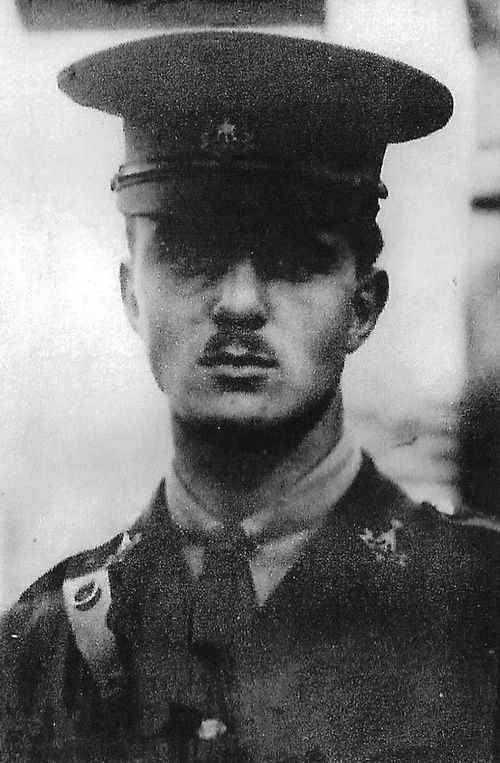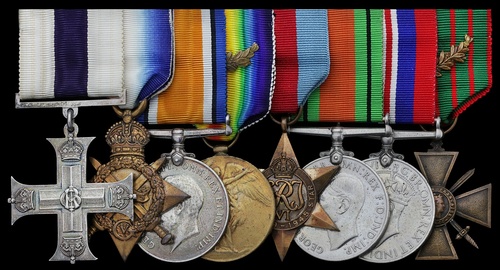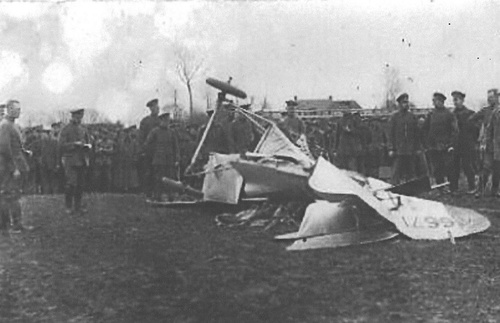Auction: 20001 - Orders, Decorations and Medals - conducted behind closed doors
Lot: 734
A Great War immediate M.C. group of eight to Lieutenant A. V. Burbury, Royal Air Force, late Yorkshire Regiment and Royal Flying Corps, a gallant 'balloonatic' who was awarded the Military Cross for escaping from his observation balloon after its cable had been cut by shell fire
Burbury survived this ordeal only to be wounded and shot down while attacking enemy balloons near Houthem; in 1919 he was dispatched to Archangel to assist White Russian forces
Possessing an extraordinary talent for languages, Burbury served throughout the Second World War as the Ministry of Information's foreign press censor; his post-war political career was overshadowed by an uncontrolled penchant for the fairer sex
Military Cross, G.V.R., unnamed as issued; 1914-15 Star (2. Lieut. A. V. Burbury. York. R.); British War and Victory Medals, with French M.I.D. emblem (Lieut. A. V. Burbury. R.A.F.); 1939-45 Star; Defence and War Medals 1939-45; France, Third Republic, Croix de Guerre 1915-1918, with palm upon riband, recently mounted in swing style, generally very fine (8)
M.C. London Gazette 14 November 1916:
'For conspicuous skill and gallantry. When observing from a balloon at a height of 3,000 feet, the cable was cut by a shell. He destroyed his papers, ripped the balloon, a most difficult operation in the air, and then got down in his parachute.'
Arthur Vivian Burbury was born at 32 Campden Hill Gardens, Kensington on 20 May 1896. Educated at St. Paul's School, he excelled in Latin and Greek literature and modern languages. An O.T.C. stalwart, he gained a fearsome reputation as a boxer, his fights regularly appearing in The Times. His plans for further study at Cambridge were interrupted by the Great War. He enlisted as a Private (No. 2345) into the 28th Battalion, London Regiment ('Artists Rifles'), from which unit he attended Sandhurst. He was gazetted 2nd Lieutenant to the 2nd Battalion, The Yorkshire Regiment on 14 July 1915, but was quickly seconded to the R.F.C. as a Staff Lieutenant. Despite gaining a Royal Aero Club Certificate (No. 1555), he was gazetted a Balloon Officer with 3 Kite Balloon Section on 1 October 1915, arriving in France on 19 November that year.
On 15 September 1916, while observing 6th Division's assault on the Quadrangle Redoubt at an altitude of 3,000 feet, Burbury's balloon drifted across the line of fire of a Royal Artillery battery, armed with 6-inch howitzers. Its commanding officer warned Burbury of the imminent danger, but given that he was ideally positioned for observing the battle, Burbury decided to run the risk. Minutes later, a shell severed his cable and he drifted towards enemy lines. His balloon was a Cacquot, a new type unknown to the enemy; its discovery by the Germans could have been disastrous. Rather than immediately abandoning his post, Burbury used the emergency 'rip panel' to prevent the balloon falling into enemy hands. This was a difficult operation to perform in mid-air, but Burbury achieved it and the balloon finally came to rest on the Allied front trenches. Having also taken the precaution of destroying his maps and papers, Burbury landed by parachute near Maricourt, inside the British lines. For his presence of mind he received an immediate M.C. and French Croix de Guerre.
Burbury then commenced Pilot Training and was gazetted Flying Officer on 16 March 1917, assigned to No. 1 Squadron. On 26 April 1917, while flying Nieuport A6671, he was assigned the 'special mission' of attacking enemy balloons near Houthem. The combat report states that Burbury destroyed one enemy balloon, then disappeared from view while heading for a second. He was reported as having been wounded, shot down by anti-aircraft fire and taken prisoner; the wreckage of his aircraft was photographed. Repatriated after the Armistice, Burbury was next posted to the North Russian Expeditionary Force, serving on the Archangel front as a Pilot and Staff Officer 4th Class from June to September 1919. He also served briefly in Ireland.
Bon Vivant
Resigning his commission in 1920, Burbury attended King's College, Cambridge, gaining an Honours degree in Modern Languages. In 1923 he applied to the Diplomatic Service and passed top of his cohort, with fluency in French, Russian, Finnish and modern Greek. He received promotion to 2nd Secretary in 1927, and went on to become Secretary of Legation in six countries. In 1938 he joined the South Kensington Labour Party, becoming its Publications Officer. At the beginning of the Second World War, Burbury was translator to the Commonwealth Agricultural Bureau in an astonishing 24 languages. He served throughout the conflict as the Ministry of Information's foreign press censor, dealing with important news telegrams. Burbury held numerous honorary posts including fellowship of the Institute of Linguistics, membership of the Royal Society of Literature, and appointment to the Council of the Poetry Society. He published widely and lectured to rapt audiences, offering private language tuition at a premium. The 1945 General Election saw him elected as Labour Councillor for the Norland Ward, North Kensington. He was also a Justice of the Peace and the Chairman of the North Kensington branch of the British Legion.
Despite his punctilious commitment to civic duty, Burbury's personal life was somewhat more chequered. He had three marriages, the first to Maisie Martin in 1920, the second to Joan Storm in 1924, and the third to Edith Payne in 1938. He fathered several children by these different marriages, but lived with Edith (and his son and two daughters, by her) at Bassett Road, North Kensington. His promiscuity was legendary, as his old Cambridge friend Lance Sieveking recalled:
'Looking back [Burbury] seems to have changed very little, and the man at all stages could be recognised, in all characteristics save one, as the boy he had been. This one particular was that, as a youth, and up to the age of 23, when in 1919 he at last came up to King's, he had a traditionally idealistic attitude towards sex and women. This changed, and in a short space of time he ceased to imitate Sir Galahad, and adopted the attitude of Don Juan. A Don Juan with a mission: to bring love and physical satisfaction into the lives of as many women as possible who might otherwise be deprived.'
After the fall of Germany in 1945, Burbury worked as a translator for the occupying American forces. In 1952, while in London, he was caught making love to an 'unnamed young lady' in his car while parked in Little Chester Street, Belgravia. The lady's 'cri de joie' was heard by P.C. Joseph Ednie while on the beat. This policeman sold his story to the Singapore Free Press. Following Burbury's trial, this newspaper reported:
'P.C. Joseph Eddie said he was attracted by a noise coming from inside the car, a low one, and looked through a partially opened window. As a result of what he saw he told Burbury to alight. Burbury claimed that what had taken place in the privacy of his own car did not constitute the "public exhibition" and "visible behaviour" which was contemplated by the law. Imposing a fine of 40s., the magistrate told Burbury: "The car was in a public place, and there were windows that the public could see through. From what the officer has said he saw happening any sophisticated member of the public walking by would at once know what was happening or about to happen."'
The irrepressible, multi-talented Arthur Vivian Burbury died in Germany in 1959. The closing remark should be left to his friend Sieveking:
'At his funeral, the church was full of women of all ages, dating back to his youth and coming right up to the newest loves of his last year. I was the only man.'
Sold with a folder of research, photographs, articles, MIC, a 1st edition copy of Burbury's romantic novel The Higher The Fewer (1927), signed by Burbury on the inside front cover, and a copy of Sieveking's letter, containing numerous other anecdotes regarding Burbury.
Subject to 20% VAT on Buyer’s Premium. For more information please view Terms and Conditions for Buyers.
Sold for
£4,500
Starting price
£3000









